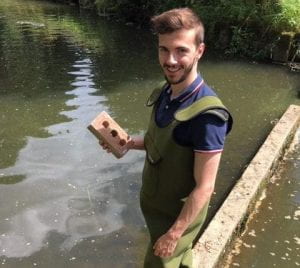The Environmental Award aims to reward and showcase inspiring environmental projects at the university, and promote sustainability in the curriculum. The Award has been developed by the University’s Sustainability Team, with panel judges from 8 different academic schools and the Green Growth Platform. It is awarded twice in the academic year, at both the summer and winter graduation ceremonies.
One winner and two runners up have been chosen for summer 2020. Pieter Fourie, BSc (Hons) Environmental Sciences, School of Environment and Technology, has been awarded the university’s Environmental Award for his project on whether microplastics in the River Ouse could act as a pathogen transmission vector.
Pieter’s research provides evidence that microplastics can act as hosts to bacteria that have the potential to cause harm to human health. The project also raises questions as to whether contaminated microplastics that settle on riverbeds could potentially contaminate the watercourse when disturbed, for example during a storm event. Pieter will be presented with his certificate during his graduation ceremony in February 2021 and will receive a £200 cash prize.
When asked what winning this year’s Environmental Award meant to him, Pieter said “I am honoured to receive the University of Brighton’s Environmental award for my dissertation project which investigated microplastics as vectors for transporting pathogens in rivers. Receiving the award has instilled a sense of great accomplishment within myself and furthered my passion for researching rivers. I hope my work can serve as a source of information and inspiration that will drive further research investigating the contamination risks posed by microplastics in rivers. I would also like to acknowledge and thank Dr. Ockelford, Dr. Purnell, and Prof. Ebdon for their fantastic supervision and input.”
Pieter has also written a blog post on the Geography, Geology and Environment blog.
The Highly Commended prize was shared by Tom Skea, MEng Civil Engineering, School of Environment and Technology and George Hearn, BSc (Hons) Environmental Sciences, School of Environment and Technology. Tom’s project focused on whether the foundations used in off-shore wind farms could be constructed in a more cost effective, more efficient manner. Tom found a previously unresearched conical pile design to outperform the current designs used, and that whilst construction costs could be higher this design would ultimately result in material savings, potentially allowing off-shore wind farms to be built in harsher conditions.
George’s project investigated the impact of an Emission Control Area (ECA) on Sulphur Dioxide concentrations within Europe using NASA’s Giovanni web interface, which enables access to data from a range of satellite instruments. George used GIS to map changes in SO2 concentration within the ECA from 2005 to 2019, and found the ECA had led to significant decreases in concentration. This research shows that using methods that explore the larger ECA rather than individual ports give a better indication as to the effectiveness of the ECAs.
When asked what being Highly Commended meant to him, George said “It truly is an honour to have the most significant piece of work I’ve ever completed acknowledged and commended by the judges and the university itself. Air pollution, and more specifically the increase in SO2 emissions, is an issue that has impacts across the world. Global trade plays a major part in these emissions and the action that is taken to reduce the emissions must be scrutinised to identify the most effective solutions.
The project was challenging as I collected, collated and analysed large amounts of data using software that I was not fully familiar with such as SNAP and ArcMap, and the final grade along with this certificate have validated the hours I put into the project and made the whole process worth it.
Overall, I learnt more than I could’ve expected whilst completing this work and this has only fuelled my ambition to research the topic further in the future and see the full capabilities of the Sentinel 5P satellite imagery and the way it can be applied to the evaluation of ECAs.”
Applications for the Winter 2021 Environmental Award, for those whose course finished after June 2020, are now open: https://blogs.brighton.ac.uk/environmentalaward/



